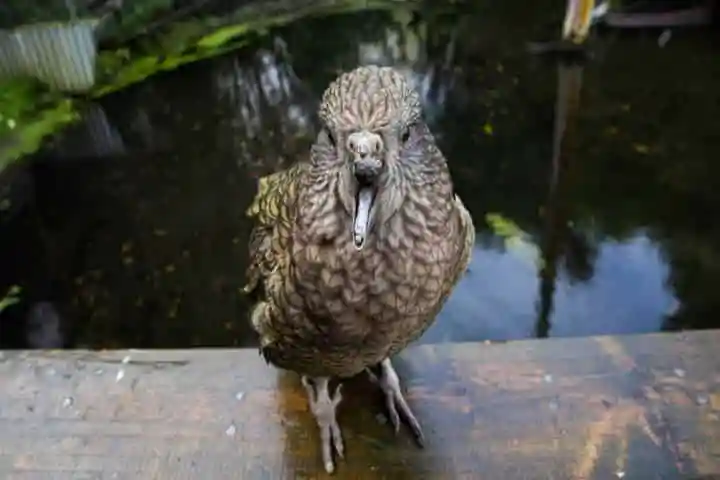

Bruce the kea who without his upper portion of beak manages to preen himself with a pebble (Pic. Courtesy smithsonianmag.com)
<p>
<strong>Disability has never curbed the survival instinct as the latter is much stronger and finds ways and means to circumvent the former. This proves true in the case of a kea from New Zealand which despite its broken beak, has learned to use tools to preen himself.</strong></p>
<p>
The kea is Bruce who was discovered without his upper half of the beak in 2013 and was tended and cared for till he became all right. Released at Christchurch&#39;s Willowbank Wildlife Reserve, he stays there with a flock of kea.</p>
<p>
Kea is an alpine parrot found only in New Zealand.</p>
<p>
According to a report in smithsonianmag.com, researchers were pleasantly surprised to note that following his recovery, Bruce was taking help of small pebbles to get rid of mites and dirt from his plumage. This was unusual as it had never been seen before though keas use their beaks for this job.</p>
<p>
<iframe allow="accelerometer; autoplay; clipboard-write; encrypted-media; gyroscope; picture-in-picture" allowfullscreen="" frameborder="0" height="315" src="https://www.youtube.com/embed/BbARqC8g2xQ" title="YouTube video player" width="560"></iframe></p>
<p>
Talking to the Guardian, the study author Amalia Bastos said: <a href="https://www.smithsonianmag.com/smart-news/bruce-the-parrot-uses-tools-to-survive-180978645/?utm_source=smithsoniantopic&amp;utm_medium=email&amp;utm_campaign=20210919-weekender&amp;spMailingID=45639055&amp;spUserID=MTI4MDgxMTczNjcwMgS2&amp;spJobID=2083949207&amp;spReportId=MjA4Mzk0OTIwNwS2">&ldquo;Kea do not regularly display tool use</a> in the wild, so to have an individual innovate tool use in response to his disability shows great flexibility in their intelligence. They&rsquo;re able to adapt and flexibly solve new problems as they emerge.&rdquo; Bastos, is a Ph.D. student at the University of Auckland School of Psychology.</p>
<p>
Bastos along with other researchers observed Bruce for nine days to understand his self-care technique. Their findings were published in Scientific Reports, a peer-reviewed journal.</p>
<p>
Bruce started by selecting a pebble of a particular size which he would fit in his lower beak. He then used his tongue to keep the pebble in place to tidy his plumage.</p>
<p>
<strong>Also read: </strong><a href="https://www.indianarrative.com/science-news/kakapos-night-birds-that-survived-even-after-inbreeding-114808.html"><strong>Kakapos – night birds that survived even after inbreeding</strong></a></p>
<p>
Initially other scientists were sceptical but the videos showed Bruce doing this continuously.</p>
<p>
Sharing details on this Bastos observed in New York Times: &ldquo;The main criticism we received before publication was, &lsquo;Well, this activity with the pebbles may have been just accidental&mdash;you saw him when coincidentally he had a pebble in his mouth&rsquo;. But no. This was repeated many times. He drops the pebble, he goes and picks it up. He wants that pebble. If he&rsquo;s not preening, he doesn&rsquo;t pick up a pebble for anything else.&rdquo;</p>
<p>
As a species keas are very intelligent and inquisitive. There are known incidents of these birds pecking apart window trim and wiper blades on cars and believe it or not even steal passports of tourists. The use of pebbles has never been seen before.</p>
<p>
<img alt="" src="https://www.indianarrative.com/upload/news/Bruce_The_Kea1_Twitter_ScienceAlert.webp" style="width: 720px; height: 480px;" /></p>
<p>
The scientists observed other keas in the Willowbank Wildlife Reserve to see if they too display this behaviour. Many were found to use sticks, etc to play but not pebbles for cleaning.</p>
<p>
In a statement of University of Auckland Baston said: &ldquo;Kea do not regularly display tool use in the wild, so to have an individual innovate tool use in response to his disability shows great flexibility in their intelligence. They&rsquo;re able to adapt and flexibly solve new problems as they emerge.&quot;</p>
<p>
<strong>Also read: </strong><a href="https://www.indianarrative.com/culture-news/smart-sulphur-crested-parrots-learn-to-open-trash-bins-and-pass-it-to-their-peers-104939.html"><strong>Smart sulphur-crested parrots learn to open trash bins and pass it to their peers!</strong></a></p>
<p>
The Reserve staff give Bruce soft food to eat but he has been seen eating harder foods by grazing them with other objects.</p>
<p>
Relating this, Bastos said: &ldquo;He&rsquo;ll pick up a piece of carrot and push it against a hard piece of metal or rock and use that to scrape with his lower bill, which again is a feeding behaviour we haven&rsquo;t seen in the other birds. It&rsquo;s not tool use but it is another interesting way he has adapted to his disability.&rdquo;</p>
Minister for Electronics and Information Technology Ashwini Vaishnaw said on Friday that the government is…
Renowned human rights activist and political analyst Amjad Ayub Mirza has expressed a strong denunciation…
As was widely expected, the Indian economy grew by 6.5 per cent in real terms…
World No Tobacco Day, marked annually on 31 May, addresses a major public health challenge--the…
Defence Minister Rajnath Singh, addressing officers and sailors onboard India's first indigenous aircraft carrier INS…
The leadership team from the Central Tibetan Administration (CTA) arrived in Tokyo to participate in…